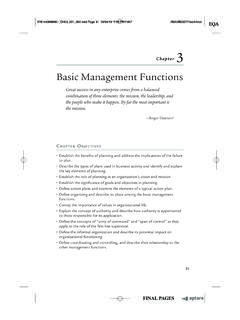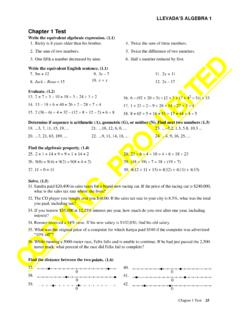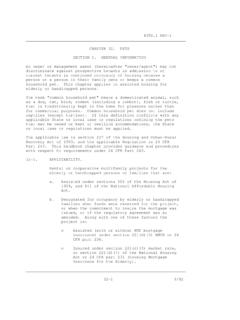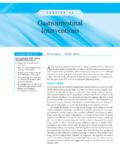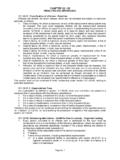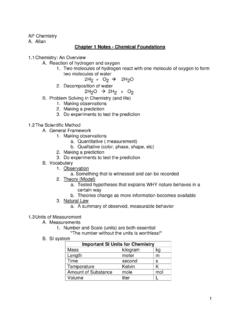Transcription of 58219 CH01 FINAL.qxd 9/11/09 12:52 PM Page 1 one
1 9/11/09 12:52 PM Page 1. Jones and Bartlett Publishers, LLC. NOT FOR SALE OR DISTRIBUTION. chapter one one The Basics of Wellness Health is a state of complete physical, mental and social well-being;. and not merely the absence of disease or infirmity.. World Health Organization (1947, 2009). OBJECTIVES. Upon the completion of this chapter , you should be able to: 1. Define the terms health, health promotion, prevention, and wellness. 2. Discuss the impact of the World Health Organization's definition of health as it applies to wellness. 3. Discuss the Healthy People initiative, particularly Healthy People 2010. 4. Compare the definitions of health and wellness. 5. Critique the definitions of wellness. 6. Differentiate between primary prevention, secondary prevention, and tertiary prevention. 7. Discuss the concept of the triad of wellness and list its components. 8. Differentiate between the six models of wellness. 9. Discuss the dimensions and sub-dimensions of the humanistic model of wellness.
2 1 . 9/11/09 12:52 PM Page 2. Jones and Bartlett Publishers, LLC. NOT FOR SALE OR DISTRIBUTION. 2 chapter 1 THE BASICS OF WELLNESS. 10. Provide a rationale for the secondary dimension of the humanistic model of wellness and determine if it is best classified as a component of the physical, mental, or social aspects of the definition of wellness. 11. Discuss the stages of wellness and apply them to yourself and others. 12. Differentiate between a lapse and relapse as well as maintenance and permanent maintenance. Apply these definitions to yourself and others. 13. Given a scenario, identify and provide a rationale for the stage of wellness in an eval- uation of a patient/client. 14. Compare the use of surveys and direct examination as methods to assess wellness. SECTION 1: HEALTH AND WELLNESS. Health In its constitution, the World Health Organization (WHO) defines health as Not merely the absence of disease .. a state of complete physical, mental and social well-being.
3 (1947, p. 7; 2009, para. 2). Thus, the WHO views health as a triad of the physical, the mental, and the social states of being. It is logical to apply the concept of health as a triad when assessing wellness and health models, if not also medical models (Figure 1-1). Health Promotion Health promotion is the science and art of helping people change their lifestyle to move toward a state of optimal health. Optimal health is defined as a balance of physical, emo- tional, social, spiritual, and intellectual health. Lifestyle change can be facilitated through a combination of efforts to enhance awareness, change behavior and create environments that support good health practices. Of the three, supportive environments will probably have the greatest impact in producing lasting change (O'Donnell, 1986, ). According to the Health Promotion Web page of the Centers for Disease Control and Prevention (CDC), Adopting healthy behaviors such as eating nutritious foods, being physically active, and avoiding tobacco can prevent or control the devastating effects of many dis- eases.
4 The CDC is committed to programs that reduce the health and economic conse- quences of the leading causes of death and disability and ensure a long, productive, healthy life for all people (2009a, para. 1). Mental Physical Health Health Social Health Figure 1-1 The World Health Organization's Triad of Health 9/11/09 12:52 PM Page 3. Jones and Bartlett Publishers, LLC. NOT FOR SALE OR DISTRIBUTION. Section 1: Health and Wellness 3. Health promotion can be described simply as purposeful activities designed to enhance the health of oneself and/or others. Wellness Countless definitions of wellness exist. Halbert Dunn (1896 1975), considered by many as the founding parent of wellness, defined it as An integrated method of functioning which is oriented toward maximizing the potential of which the individual is capable, within the environment in which [she or] he is functioning (1961, p. 4). Dunn served as a public health physician and was the first nationally recognized medical doctor to explore the concept of wellness.
5 A current leader in the arena of wellness is Don Ardell (1938 ), PhD. Ardell, who wrote the first mass-market wellness book entitled High Level Wellness, offered several definitions of wellness. In 1985, he stated that wellness is a dynamic or ever-changing, fluctuating state of being (p. 5). In 1986, Ardell added that wellness is giving care to the physical self, using the mind constructively, channeling stress energies positively, expressing emotions effectively, becoming creatively involved with others, and staying in touch with the environment. In 1999, Ardell stated that Wellness is about perspec- tive, about balance and about the big picture. It is a lifestyle and a personalized approach to living your life in such a way that you enjoy maximum freedom, including freedom from illness/disability and premature death to the extent possible, and free- dom to experience life, liberty and the pursuit of happiness. It is a declaration of inde- pendence for becoming the best kind of person that your potentials, circumstances and fate will allow (p.)
6 1). The American Physical Therapy Association (APTA), in its Guide to Physical Thera- pist Practice, defined wellness as the concepts that embrace positive health behaviors that promote a state of physical and mental balance and fitness (2001b, p. 691). Because this definition excludes the social realm of the wellness triad, I consider it narrow in scope and therefore flawed. A number of physical therapists who possess an expertise in wellness have provided more comprehensive definitions of wellness. For example, Janet Bezner, who currently serves as the APTA's Senior Vice President of Education, proposed that, wellness is an individualistic con- cept that is multidimensional and more than just physical health habits .. Wellness is about positive health actions .. Said best, wellness is a lifestyle process that never ends .. (per- sonal communication, September 22, 2004). This description of wellness is strong in several aspects.
7 Most importantly, it recognizes and emphasizes that wellness is individualistic, multi- dimensional, and dynamic in nature. As many regard me as an expert in the field of wellness as it relates to physical therapy, the following is my definition of wellness: A lifestyle that promotes physical, mental, and social health in the cognitive, psychomotor, and affective domains, both internally and exter- nally (Fair, 2000b). This definition is based upon the following terminology and concepts: Lifestyle: Wellness is a process (Ardell, 1986b; Dunn, 1961; Jonas, 2000). Physical, mental, and social health: a state of complete physical, mental and social well-being (WHO, 1947, p. 29; 2009, para. 2). 9/11/09 12:52 PM Page 4. Jones and Bartlett Publishers, LLC. NOT FOR SALE OR DISTRIBUTION. 4 chapter 1 THE BASICS OF WELLNESS. Cognitive: Knowledge or mental skills (Bloom, 1956, 1984) ( , knowledge about wellness as demonstrated by words and or actions).
8 Psychomotor: Physical actions or skills (Simpson, 1972) ( , wellness-related behaviors and practices). Affective: Feelings (Krathwohl, Bloom, & Bertram, 1973) ( , the commit- ment to a lifestyle that promotes wellness). Internal: Individual or self-wellness (APTA, 2001b; Ardell, 1986b; CDC, 2007b; Dunn, 1961; Jonas, 2000). External: Those aspects of wellness that are outside of the individual, such as family wellness (Ardell, 1986b; Dunn, 1961). Community wellness (APTA, 2001b; Dunn, 1961; Jonas, 2000). Environmental wellness (Ardell, 1986b; Dunn, 1961; Jonas, 2000). My definition of wellness proposes that if a person possesses a satisfactory level of an aspect of wellness, then that individual is aware of specific activities promoting that aspect of wellness, is committed to that aspect of wellness, and participates in activities that promote that aspect of wellness. For example, if Jane 1) knows about a number of activities that promote fitness, 2) participates in those activities, and 3) is committed to a lifestyle that promotes a satisfactory level of fitness wellness, then she has a satisfac- tory level of fitness wellness.
9 In contrast, if Jane is 1) unaware of how to be fit, 2) does not engage in activities that promote fitness wellness, and/or 3) does not care about her personal fitness, then Jane has an unsatisfactory level of fitness wellness. Of course, one may have a satisfactory level of wellness in one dimension of wellness ( , aerobic capacity wellness or nutritional wellness) but have an unsatisfactory level in another aspect of wellness ( , flexibility wellness or mental wellness). It is important to re- iterate that an individual is defined as having a satisfactory level of wellness only if she or he possesses each of three domains cognitive, psychomotor, and affective but an individual has an unsatisfactory level of wellness if she or he is missing one or more of the three domains. Health Versus Wellness Some professional organizations have adopted the WHO definition of health based upon the physical, mental, and social triad. The American Occupational Therapy Association (AOTA) supports the notion that health is the absence of illness, but not necessarily dis- ability, a balance of physical, mental and social well-being attained through socially val- ued and individually meaningful occupation; enhancement of capacities and opportunity to strive for individual potential; community cohesion and opportunity; and social inte- gration, support and justice, all within and as part of a sustainable ecology (Wilcock, as cited in AOTA, 2000, p.
10 656). Other professional organizations, including the APTA (as previously discussed), have not adopted WHO's paradigm. While components of health are measured at a specific point in time ( , a blood pressure reading or a Beck Depression Inventory score), wellness is an active process that consists of habits and practices (National Wellness Institute, ). Accordingly, in con- trast to health, which is static; wellness is dynamic. An individual does not have to be 9/11/09 12:52 PM Page 5. Jones and Bartlett Publishers, LLC. NOT FOR SALE OR DISTRIBUTION. Section 2: Prevention 5. healthy to be well. Individuals with acute or chronic medical disorders, including a termi- nal disease such as some forms of cancer, can be well as long as they are practicing a healthy lifestyle. Likewise, an individual does not have to be well to be healthy. For exam- ple, a person may be considered healthy if she or he does not exhibit any signs or symp- toms of illness or disease; but that individual nonetheless may be engaging in unhealthy behaviors, such as excessive consumption of junk foods.









